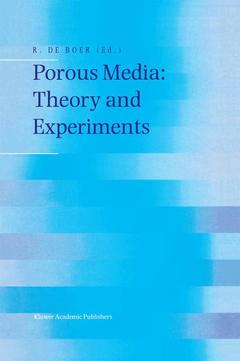Description
Porous Media: Theory and Experiments, Reprinted from TRANSPORT IN POROUS MEDIA, 34:1-3, 1999
Coordinator: de Boer Reint
Language: English
Subjects for Porous Media: Theory and Experiments:
Keywords
chemical engineering; dynamics; mechanics; modeling; soil mechanics; transitions; transport
Publication date: 10-2012
336 p. · 15.5x23.5 cm · Paperback
336 p. · 15.5x23.5 cm · Paperback
Description
/li>Contents
/li>
The EUROMECH Colloquium 366, 'Porous Media - Theory and Experiments' was held at the Bildungszentrum fiir die Entsorgungs-und Wasserwirtschaft GmbH B·E·W, Essen, Germany, from 23 to 27 June 1997. The goal of EUROMECH 366 was the presentation of recent findings in the macroscopic porous media theory (mixture theory restricted by the volume fraction concept) concerning general concepts and special investigations in the theoretical as well as the experimental field. Herein, numerical results requiring new solution strategies were also to be included. Moreover, foundations of fundamental state ments in the macroscopic porous media theory (e.g. the effective stress principle for incompressible and compressible constituents by micromechanic investigations) were welcome. Emphasis was placed upon the need to bring together scientists from various branches where porous media theories playa dominant role, namely from theoretical mechanics, agriculture, biomechanics, chemical engineering, geophysics and soil mechanics as well as from petroleum energy and environmental engineering. More than 80 people from 12 different countries expressed their interest in the Colloquium, and finally, 58 took part in the meeting presenting 42 papers. Among the talks were seven principal lectures given by leading scientists in the a.m. fields invited by the organizers. As Chairman of EUROMECH 366, I would like to thank the co-chairmen and all of my co-workers from the Institute of Mechanics, FB 10, University of Essen, for their help in organizing the Colloquium, in particular, Dr.-Ing. W. Walther, Priv.-Doz.
Preface; R. De Boer. 1. On the Role of the Interface Mechanical Interaction in a Gravity-driven Shear Flow of an Ice-till Mixture; T. Wu, K. Hutter. 2. Finite Deformation Models and Field Performance; S. Arnod, et al. 3. The Peculiarities of Linear Wave Propagation in Double Porous Media; A.A. Gubaidullin, O.Y. Kuchugurina. 4. A Micromechanics-based Approach to the Failure of Saturated Porous Media; P. De Buhan, L. Dormieux. 5. Contributions to Theoretical/Experimental Developments in Shock Waves Propagation in Porous Media; S. Sorek, et al. 6. Saturated Compressible and Incompressible Porous Solids: Macro- and Micromechanical Approaches; A.K. Didwania, R. De Boer. 7. Wave Dynamics of Saturated Porous Media and Evolutionary Equations; I.Y. Edelmann. 8. Thermo-Chemo-Electro-Mechanical Formulation of Saturated Charged Porous Solids; J.M. Huyghe, J.D. Janssen. 9. Transport of Multi-electrolytes in Charged Hydrated Biological Soft Tissues; V.C. Mow, et al. 10. Localization Phenomena in Liquid-Saturated and Empty Porous Solids; W. Ehlers, W. Volk. 11. Finite Elastic Deformations in Liquid-Saturated and Empty Porous Solids; W. Ehlers, G. Eipper. 12. A Micropolar Theory of Porous Media: Constitutive Modelling; S. Diebels. 13. Propagation and Evolution of Wave Fronts in Two-phase Porous Media; Z. Liu, R. De Boer. 14. Computer Simulation of Drying. Optimal Control; S.J. Kowalski, A. Rybicki. 15. Deformations and Stresses in Dried Wood; S.J. Kowalski, G. Musielak. 16. Phase Transitions in Gas and Liquid-Saturated Porous Solids; R. De Boer, J. Bluhm. 17. A Simple Model for Fluid-filled Open-cell Foam; U. Dünger, et al. 18. Quasistatic and Dynamic Behaviour of Saturated Porous Media with Incompressible Constituents; S. Breuer. 19. A Linear Theory of Porous Elastic Solids; P. Giovine. 20. Derivation of Matching Conditions at the Contact Surface Between Fluid-Saturated Porous Solid and Bulk Fluid; M. Cieszko, J. Kubik.
© 2024 LAVOISIER S.A.S.




